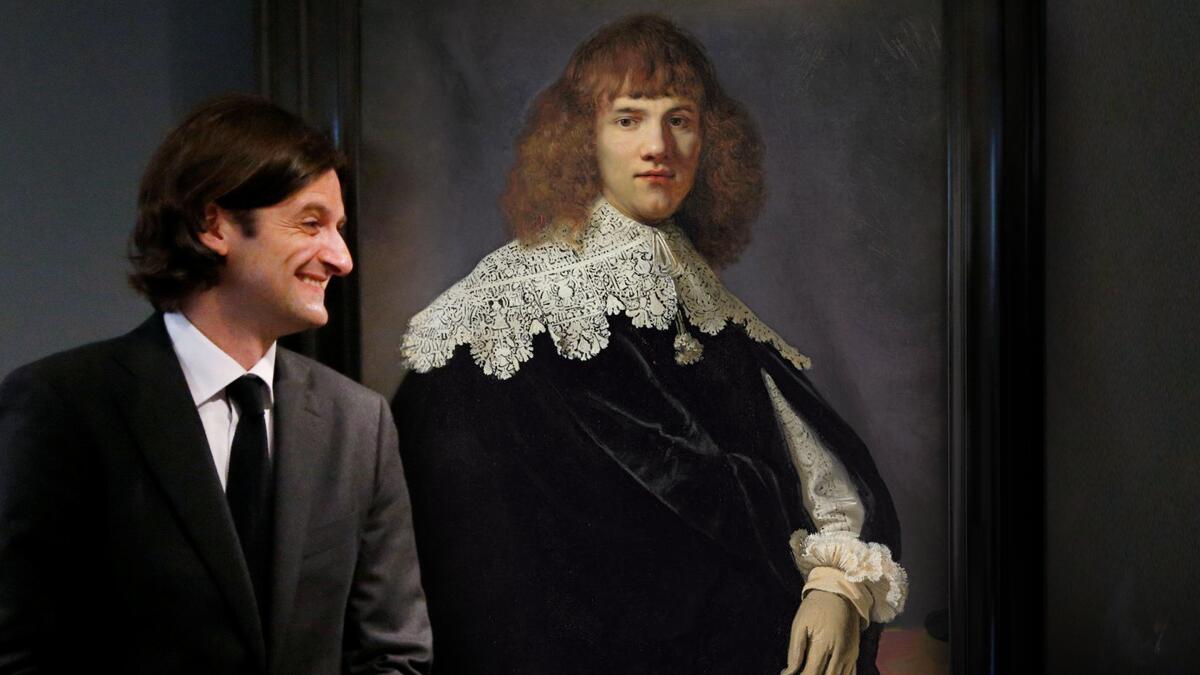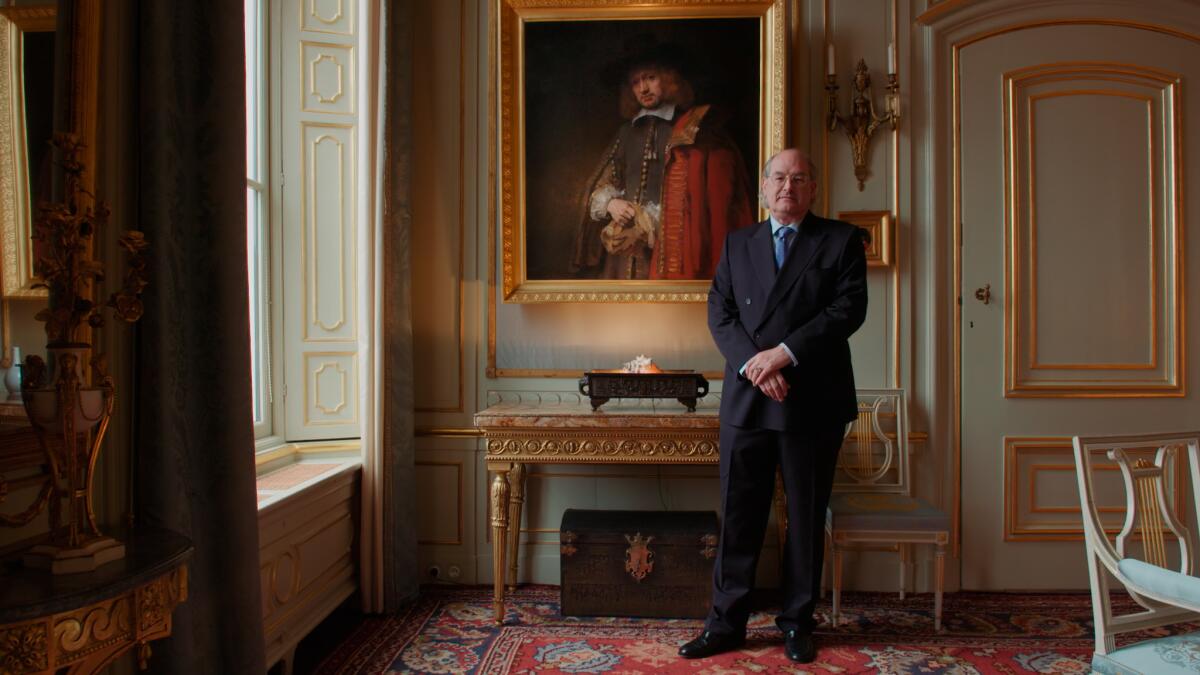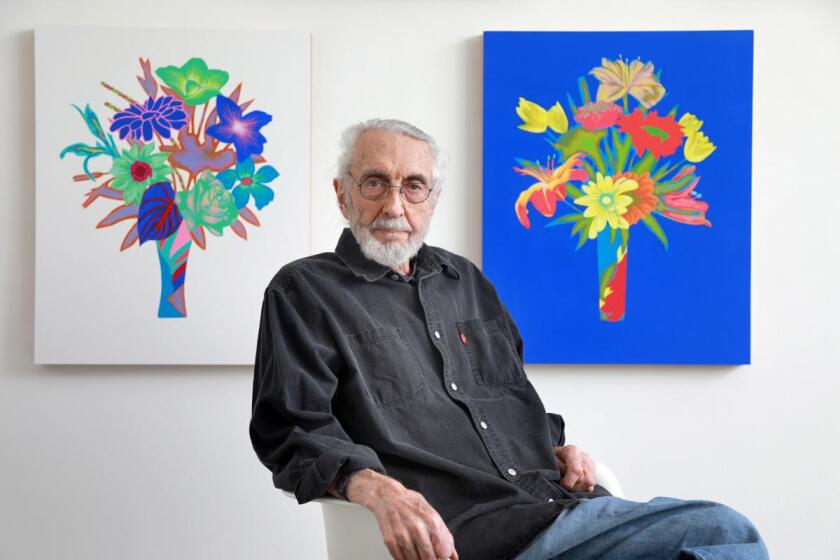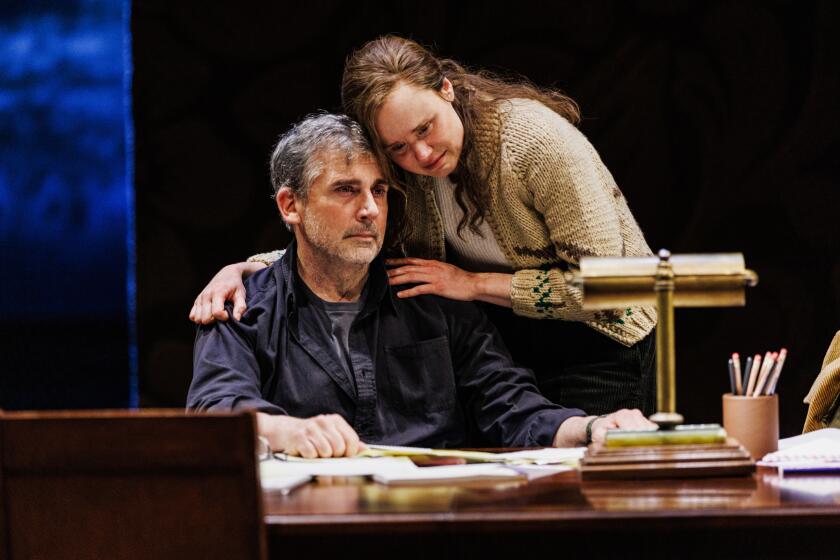Review: How does it feel to own a Rembrandt? Or 15 of them? Inside the collectors’ quest

The 2019 documentary “My Rembrandt,” available for streaming beginning Wednesday, is less a film about the iconic 17th century Dutch painter of the film’s title than it is an acute, often fascinating and occasionally puzzling rumination on aspects of the other titular word — “my.”
One lesson of the film, ably helmed by director Oeke Hoogendijk, is that to love an artist’s work is to possess it, whether physically, intellectually, emotionally or any combination thereof — including, perhaps, corruptly. Passion for an artist’s work comes in many forms.
Hoogendijk knows her way around Dutch Golden Age painting and today’s complicated cultural landscape, having spent a decade documenting the renovation and expansion of the Rijksmuseum, Amsterdam’s incomparable repository. The success of that much-admired earlier film likely gave her unusual access to the art-world elite who open up in “My Rembrandt.”
Her cinematographers, Sander Snoep and Gregor Meerman, are superlative, especially in detailed scrutiny of paintings. The film’s protagonists are art collectors, dealers, museum curators, historians, connoisseurs, auctioneers, government officials — most but not all of them men, and all focused attentively on Rembrandt Harmenszoon van Rijn (1606-1669).
The ambitious young painter from the modest university town of Leiden, launching pad for the cultivation of the Asian tulip throughout Europe, came to Amsterdam at the age of 25. Ninth child of a prosperous miller and a baker’s daughter, he proceeded to set the absurdly prosperous city on its sophisticated ear.
Wielding an incomparable, sometimes even astounding facility with the brush, Rembrandt merged close and candid observation of the world around him with inventive theatrical narratives drawn from myth, history and the Bible. Portraiture, including self-portraiture, was his early avenue into the relentless demands of intimate scrutiny.
It also provides a bit of unadvertised wit for the film’s U.S. streaming-service launch on Virtual Cinema, hosted by Film Forum in New York. (Streaming goes wide on Jan. 22, including Laemmle Virtual Cinema in Los Angeles.) The date of Wednesday’s debut is Jan. 6, and Jan Six happens to be the name of the sitter in one of Rembrandt’s most celebrated portraits — a powerful lawyer, politician and friend of the artist.
Jan Six is also the name of his descendent, 10 generations on, whose story is one main thread of the documentary. Four years ago, the young art historian and dealer (actually Jan Six XI) stumbled upon a discovery while almost absent-mindedly thumbing through a Christie’s auction catalog for a day sale in London. A portrait of a fashionable young aristocrat looked too good for such a minor auction, while the artist-attribution — “Circle of Rembrandt” — made no sense.
Rembrandt was still a young 20-something, hardly established enough to have developed a circle of followers or imitators between 1633 and 1635. The unsigned painting’s date had been nailed down by the briefly popular style of flashy lace collar worn by the pictured aristocrat.

Later, Six also realized that the extravagant collar, symbol of social and economic status, betrayed an early example of a distinctive Rembrandt trait. To render such intricate lace in a manner that would give it visually tactile materiality, the artist would often do two things.
First, he painted an area solid white, then filled in with light-absorbing black paint the negative spaces between the design’s woven threads, giving painterly heft to thin air. Second, somewhere along the collar’s edge he would make a small piece of lace curl up and away from the velvet or satin fabric of the garment beneath it.
Together, the techniques injected an appearance of spatial volume into the heavy flatness of starched collars. Rembrandt’s gorgeous 1637 “Portrait of a Man Holding a Black Hat” in the UCLA Hammer Museum’s collection handily demonstrates the savvy painterly device.
Six, fueled by a burning desire to make a name for himself independent of his celebrated family — and, not incidentally, make a killing in the market at the same time — snapped up the misattributed picture at Christie’s auction. He paid $173,000, nearly seven times the high estimate.
Now almost universally accepted as an authentic, previously unknown early Rembrandt, the picture would be valued in the tens of millions.
Over several years, “My Rembrandt” follows the ins and outs of authenticating the portrait. Dramatic intimations turn up of possible untoward behavior on the part of some of the saga’s participants — a business partner who claims to have been pushed out of the deal, an influential art historian who at first refuses and later accepts the attribution after solving a mystery around the composition. (Originally a double portrait, the canvas had been cut down.)
But that is not the film’s real focus. The anxious, highly personal nature of Six’s pursuit is — at least, in part. Hoogendijk interweaves his personal triumph with four other equally individual tales.
There’s the frankly nasty story of an international diplomatic row over the acquisition of a pair of full-length Rembrandt wedding portraits of Marten Soolmans and Oopjen Coppit, wealthy Amsterdam newlyweds. The sterling paintings are being sold, apparently for tax purposes, by Baron Eric de Rothschild in Paris. (Unmentioned is that a chunk of the Rothschild collection was sold to the family in the 19th century by Jan Six’s family; small world.) The Louvre Museum and the Rijksmuseum both claim priority for acquiring them.
Yet neither one proves able to raise the necessary $174 million to seal the deal. The two museums must share the spoils. End of squabble, if not of lingering acrimony.
The longtime Claremont Graduate University professor was known for vivid paintings and tiny, dollhouse-like dioramas of human drama.
Money is barely an issue for American billionaire Thomas S. Kaplan, who has amassed since 2003 some 250 mostly Dutch paintings and drawings for his Leiden Collection. (The only works in private hands by Jan Vermeer and Carel Fabritius, Rembrandt’s gifted pupil who died in a freak gunpowder magazine explosion, are among them.) Fifteen are by Rembrandt, a number that seems to astonish even Kaplan.
“It doesn’t take a genius to be a collector,” he once told the German outlet Deutsche Welle. “It takes a genius to be Rembrandt.”
Kaplan appears sincere in touting his ambition to create a lending library that will keep great paintings in public rather than private view. He says he has never lived with any of his 15 Rembrandts, even for a day. The film doesn’t mention, though, that a program of perpetual museum loans also relieves a collector from many of the hefty costs for care and insurance.
Meanwhile in Scotland, the Duke of Buccleuch is fretting over rehanging Rembrandt’s midlife masterpiece, “Old Woman Reading,” from a high perch on a high floor at the family castle, Drumlanrig, where his father moved it for protection after a brazen burglary in 2003. In broad daylight, thieves snatched Leonardo da Vinci’s “Madonna of the Yarnwinder” hanging adjacent. (The panel was found four years later, unscathed.) Kaplan may not want to live with a Rembrandt but the current duke does.
A special private sitting room is being built for the poignant painting, which has been in the family for more than a century. Never before, or since, has the act of reading a book been rendered with such imposing gravity. Contemplative pleasure motivates the cheerful duke.
Finally, and somewhat oddly, Rose-Marie and Eijk de Mol van Otterloo, Dutch expats and important art collectors living outside Boston, turn up. Their celebrated collection of Dutch and Flemish paintings is pledged to that city’s Museum of Fine Arts, but it is not their delicately rendered, atmospheric “Portrait of Aeltje Uylenburgh” by Rembrandt that occasions their appearance in the film.
Instead, expressing elation at the Six discovery and dismay at the public brouhaha around it, the low-key couple represents a kind of unsullied purity of cultural commitment. Rembrandt’s own life was a tabloid-worthy roller coaster of boisterous success, terrible personal tragedy and grim financial adversity. In the documentary’s narrative, the Van Otterloos have the rather thankless role of being gentle scolds.
'My Rembrandt'
Not rated
Running time: 1 hour, 37 minutes
Playing: Begins streaming Wednesday on Virtual Cinema hosted by Film Forum in New York; streaming expands on Jan. 22 to outlets including Laemmle Virtual Cinema
More to Read
The biggest entertainment stories
Get our big stories about Hollywood, film, television, music, arts, culture and more right in your inbox as soon as they publish.
You may occasionally receive promotional content from the Los Angeles Times.








